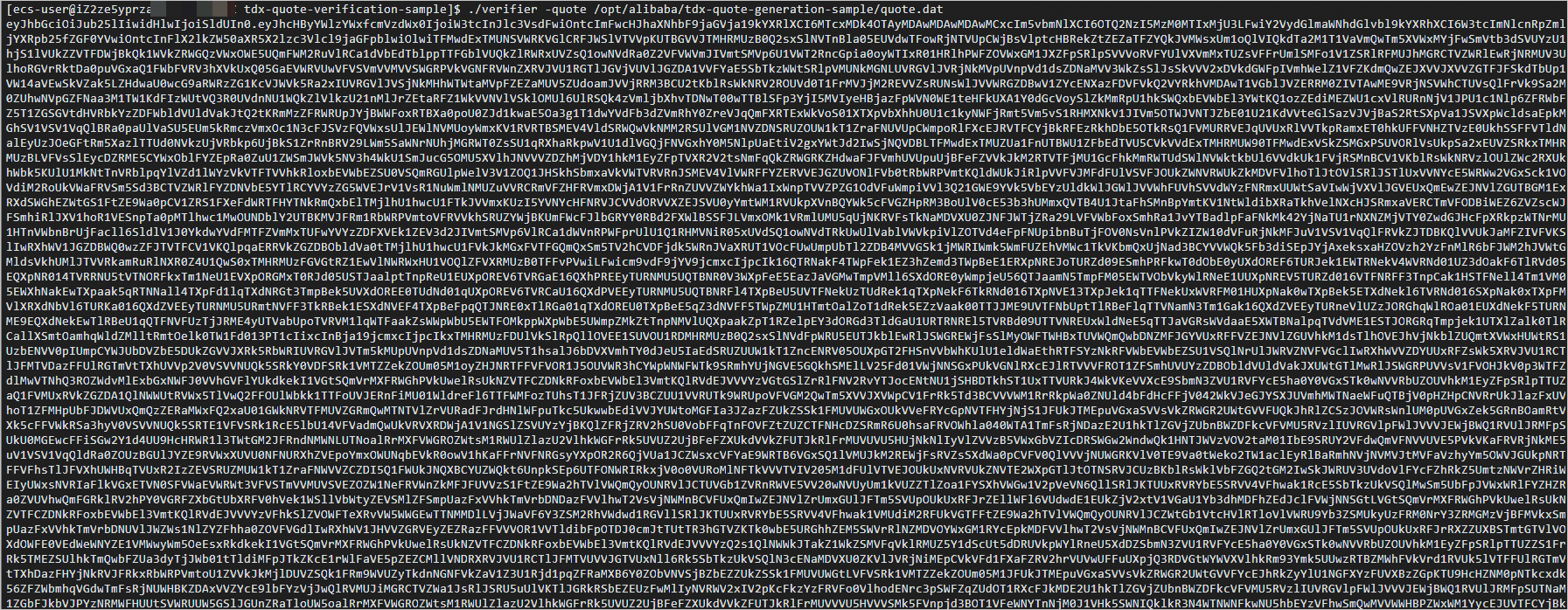Use RelyingParty to verify the identity of the JWT signature.
Command outputs similar to the command outputs shown in the following figure are returned. In the command outputs, only specific fields are displayed.
[
{
"result": {
"appraisal_check_date": 1710400829000000000,
"nonce": 502551065253582,
"certification_data": [
{
"certification_data": {
"qe_identity_issuer_chain": "LS0t...",
"root_ca_crl": "MzA4...",
"pck_crl": "LS0t...",
"pck_crl_issuer_chain": "LS0t...",
"tcb_info": "eyJ0...",
"qe_identity": "eyJl...",
"tcb_info_issuer_chain": "LS0t..."
}
}
],
"overall_appraisal_result": 1,
"appraised_reports": [
{
"appraisal_result": 1,
"detailed_result": [
{
"td_mrownerconfig_check": true,
"td_xfam_check": true,
"td_mrservicetd_check": true,
"td_attributes_check": true,
"td_rtmr3_check": true,
"td_mrtd_check": true,
"td_mrowner_check": true,
"td_rtmr0_check": true,
"td_mrconfigid_check": true,
"td_rtmr1_check": true,
"td_rtmr2_check": true
}
],
"policy": {
"environment": {
"description": "Application TD TCB 1.5",
"class_id": "45b734fc-aa4e-4c3d-ad28-e43d08880e68"
},
"signature": "-6C0-...",
"reference": {
...
},
"signing_key": {
"kty": "EC",
"crv": "P-384",
"alg": "ES384",
"y": "CeW8...",
"x": "NmSa..."
}
},
"report": {
"environment": {
"Description": "Application TD TCB",
"class_id": "45b734fc-aa4e-4c3d-ad28-e43d08880e68"
},
"measurement": {
"tdx_mrownerconfig": "0000...",
"tdx_mrservicetd": "3D03...",
"tdx_xfam": "00000000000642E7",
"tdx_mrtd": "0A40...",
"tdx_mrowner": "0000...",
"tdx_attributes": "0000000010000000",
"tdx_mrconfigid": "0000...",
"tdx_reportdata": "D98B...",
"tdx_rtmr3": "0000...",
"tdx_rtmr2": "0000...",
"tdx_rtmr1": "6368...",
"tdx_rtmr0": "D0FD..."
}
}
},
{
"appraisal_result": 1,
"detailed_result": [
{
"platform_provider_id_check": true,
"sgx_types_check": true,
"cached_keys_check": true,
"smt_enabled_check": true,
"accepted_tcb_level_date_tag_check": true,
"advisory_ids_check": true,
"expiration_date_check": true,
"tcb_eval_num_check": true,
"earliest_accepted_tcb_level_date_tag_check": true,
"tcb_status_check": true,
"dynamic_platform_check": true
}
],
"policy": {
"environment": {
"description": "Alibaba Cloud Evaluation Num Policy for TDX Platform",
"class_id": "f708b97f-0fb2-4e6b-8b03-8a5bcd1221d3"
},
"signature": "l00p...",
"reference": {
"accepted_tcb_status": [
"UpToDate"
],
"allow_dynamic_plaform": true,
"min_eval_num": 16
},
"signing_key": {
"kty": "EC",
"crv": "P-384",
"alg": "ES384",
"y": "7hlr...",
"x": "OSbD..."
}
},
"report": {
"environment": {
"description": "TDX Platform TCB",
"class_id": "f708b97f-0fb2-4e6b-8b03-8a5bcd1221d3"
},
"measurement": {
"earliest_issue_date": "2018-05-21T10:45:10Z",
"is_cached_keys_policy": true,
"fmspc": "90C06F000000",
"is_smt_enabled": true,
"earliest_expiration_date": "2024-04-02T10:22:51Z",
"root_ca_crl_num": 1,
"root_key_id": "9309...",
"pck_crl_num": 1,
"tcb_eval_num": 16,
"latest_issue_date": "2024-03-13T15:45:02Z",
"tcb_status": [
"UpToDate"
],
"tcb_level_date_tag": "2023-08-09T00:00:00Z",
"is_dynamic_platform": true,
"sgx_types": 1
}
}
},
{
"appraisal_result": 1,
"detailed_result": [
{
"td_qe_expiration_date_check": true,
"td_qe_tcb_eval_num_check": true,
"td_qe_earliest_accepted_tcb_level_date_tag_check": true,
"td_qe_tcb_status_check": true,
"td_qe_accepted_tcb_level_date_tag_check": true
}
],
"policy": {
"environment": {
"description": "Alibaba Cloud Num Policy for Verified TDQE",
"class_id": "3769258c-75e6-4bc7-8d72-d2b0e224cad2"
},
"signature": "l00p...",
"reference": {
"accepted_tcb_status": [
"UpToDate"
],
"min_eval_num": 16
},
"signing_key": {
"kty": "EC",
"crv": "P-384",
"alg": "ES384",
"y": "7hlr...",
"x": "OSbD..."
}
},
"report": {
"environment": {
"Description": "RAW TDX QE Report",
"class_id": "3769258c-75e6-4bc7-8d72-d2b0e224cad2"
},
"measurement": {
"earliest_expiration_date": "2025-05-21T10:50:10Z",
"earliest_issue_date": "2018-05-21T10:45:10Z",
"root_key_id": "9309...",
"tcb_eval_num": 16,
"latest_issue_date": "2018-05-21T10:50:10Z",
"tcb_status": [
"UpToDate"
],
"tcb_level_date_tag": "2023-08-09T00:00:00Z"
}
}
}
]
}
}
]
 Elastic Compute Service (ECS)
Elastic Compute Service (ECS)
 Container Compute Service (ACS)
Container Compute Service (ACS)



































